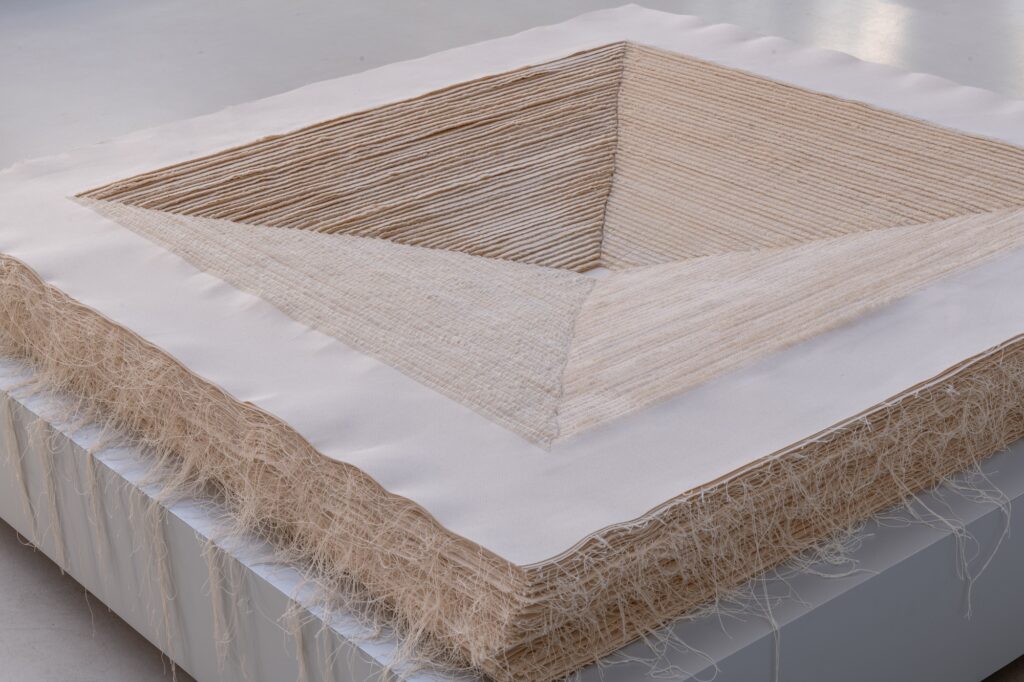Sophie Rowley: Repetition is a Form of Change
Looiersgracht 60 presented Repetition is a Form of Change, Sophie Rowley’s first major solo exhibition that followed on a 1-month residency the artist had at the non-profit space in August. The exhibition was on view between September 19-October 20th, 2024.
Looiersgracht 60, the Amsterdam-based non-profit exhibition centre for art, design and architecture, invited German-New Zealand artist Sophie Rowley for a 1-month residency and a major solo show this past fall. The exhibition, Repetition is a Form of Change, featured a selection of her work made over the past two-years, including several large-scale paintings made from yarn, some new sculptural works, and two site-specific installations.
The title of the show, Repetition is a Form of Change, comes from a line she heard on the radio in connection with Brian Eno’s “Oblique Strategies” cards that were designed to help unblock creativity in the minds of artists and musicians. Rowley connected to the phrase immediately, seeing her work in this concept. “[My work] is time consuming, it can be tedious and not always linear. Sometimes it’s meditation, sometimes it’s a struggle, other times it’s pure joy. There are many emotions that come up during the work and the repetitive gestures. And through that, I create something new and transformed.”
Rowley’s work is known for its precise, repetitive and meticulous nature that includes cutting and unravelling threads from cotton or linen canvas to create surprising and stunning motifs and patterns. In a new sculptural work titled Lying Work 150, Rowley has placed a pile of 150 sheets of cotton canvas into which she has ‘excavated’ the layers to create an intricate, striated geometric pattern that descends inward several layers towards the core of the canvas. Rowley used traditional artist’s canvas, noting that, “I like the idea that the surface was originally meant to hold a painting, and then transform that.” Lying Work 150 crosses categorisation, becoming at once a sculpture, a textile-based artwork, and even a painting – if you want to stretch the ideas of what a painting can be. It’s minimalist yet highly detailed and layered. The edges are left frayed and loose, adding the textural aspect of the piece. She says, “My work has always been about layers, but exhibition I wanted to really push that, and this was an idea I had wanted to try for years.”
Lying Work 150 has a soft palette of cream, beige and pink that was accidental. When she ordered the cotton canvas, some packages were slightly different shades – some being more yellow or pink or beige. This is the often-unknown outcome of how hot the summer was and how the cotton colour was affected by the sun. At first Rowley was irritated by the different shades, but then she decided to use it to her advantage, placing different layers to then create this soft colour gradation when revealed. It took Rowley and a team of five assistants nearly a month to complete this work.
The residency allowed Rowley time to experiment on new projects and challenge herself in new ways, including with two site-specific sculptures for the exhibition. In one, a column of long hanging threads descends from the ceiling down to the floor. Placed over a skylight, the sculpture becomes like a spotlight, a light-space installation. In another, larger work, Thread Sculpture, she used poles and thread to create a dynamic installation. She had played around with this idea in her studio before, using toothpicks as the scale model, but here, the work is over life-sized, filling a corner of the large exhibition space.
The pairing between Rowley’s delicate, subtle artworks within the very industrial space created an unexpected and positive contrast. The colour tones of the walls, the peeled paint, marks and imperfections helped to highlight the movement and repetition in her work and the soft tones and details. At the entrance, rather than the usual wall text, they placed a short poem written by Rowley last year. The poem is based on her own personal internal processes and deconstruction that she has been going through, in part connected to her upbringing in a fundamentalist community. She broke out of it in her late teens, but explains that is “only now that I understood what the dogmas are and how the structure is set up to keep people in place. There is a strong metaphor between the work I am doing and my experiences; Breaking through the structure and creating something new.” Rowley sees structures as something that should not be permanent but impermanent, something to be questioned and undone if we feel it is wrong.
The poetic nature of Rowley’s work is felt deeply in this comprehensive exhibition. Her subtlety, discipline, experimentation and layering incite unexpected emotions, a connection to something untold.
Repetition is a Form of Change was on view at Looiersgracht 60 between September 19th-October 20th, 2024.




















